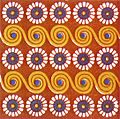Motif facts for kids
A motif in art is like a special design, pattern, or idea that shows up again and again. Think of it as a repeated theme or image that you see many times in a piece of art, a building, or even a story. These repeated elements help make the artwork interesting and can sometimes carry a special meaning.
For example, the swirly Paisley designs you might see on clothes or scarves are a type of motif. Many beautiful patterns found in mosques (places of worship for Muslims) are also motifs, often repeating geometric shapes or plant designs. In ancient Roman art, you might find motifs like the "egg and tongue" pattern or the "ball and reel" design, which were used to decorate buildings.
Contents
What Makes a Motif?
A motif is more than just a simple pattern. It's an element that is repeated and often has a purpose or a special meaning within the larger artwork. It can be:
- A shape or design: Like a specific flower, animal, or geometric pattern.
- A color or texture: Certain colors or ways things feel can be repeated to create a motif.
- An idea or theme: In stories, a motif might be a recurring idea like good versus evil, or a symbol like a specific type of tree.
Motifs help to create a sense of rhythm and unity in art. They can also help you understand the culture or time period the art came from.
Motifs Around the World
Motifs are found in art and design all over the world and throughout history. They often reflect the beliefs, nature, and daily life of the people who created them.
Ancient and Classical Motifs
- Egyptian Art: Ancient Egyptians often used motifs like the scarab beetle (a symbol of rebirth), the ankh (a symbol of life), and hieroglyphs (picture writing) in their tombs and temples.
- Greek and Roman Art: Besides the egg and tongue or ball and reel, you'll see motifs like the acanthus leaf (a plant design) used in columns and carvings. The meander or "Greek key" pattern is another famous example, a continuous line that folds back on itself.
Islamic Art Motifs
Islamic art is famous for its incredible use of motifs, especially because it often avoids showing people or animals. Instead, artists use:
- Geometric Patterns: Complex designs made from repeating squares, circles, and stars. These patterns can go on forever, symbolizing the infinite nature of God.
- Calligraphy: Beautifully written Arabic script, often from the Quran, used as a decorative motif.
- Arabesque: Flowing, swirling patterns of leaves, vines, and flowers that intertwine. These designs are often seen in mosques, books, and textiles.
Asian Art Motifs
- Chinese Art: Motifs like dragons (symbolizing power and good fortune), phoenixes (rebirth), and lotus flowers (purity) are very common.
- Japanese Art: You might see motifs of cherry blossoms (the beauty of life), waves (strength), or cranes (long life).
Why Are Motifs Important?
Motifs are important for several reasons:
- Beauty and Decoration: They make things look beautiful and interesting.
- Meaning and Symbolism: They can carry deep meanings or represent important ideas. For example, a dove motif might symbolize peace.
- Cultural Identity: Motifs often represent the unique style and beliefs of a culture or group of people.
- Storytelling: In stories or movies, a recurring object or idea can be a motif that helps to develop the plot or characters.
So, next time you look at a piece of art, a building, or even a piece of clothing, try to spot the motifs! You might be surprised by how many you find and what they tell you.
Images for kids
-
Ajanta Cave ceiling motif before entrance, India




